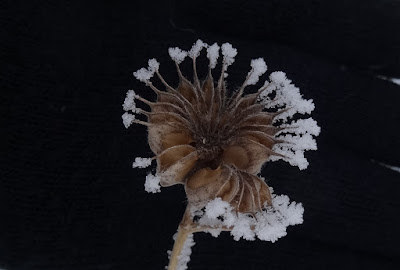This year December was a weird month weather-wise. The water level in the pond was lower every day, since we had no measurable snow this winter. Then on the December 25th it rained all day long. The next day, the water level had gone up and the log was again in the pond.
12/31/2023
9/18/2022
6/12/2022
smooth penstemon
Foxglove Beardtongue, Penstemon digitalis (also called Smooth Penstemon) has white flowers that bloom for a month or longer.
The tubular flowers attract long-tongued bees such as bumblebees and mason bees, as well as hummingbirds. This is one of the plants we are trying to encourage in the riparian area around the pond.
Good for pollinators!
11/24/2021
song sparrow feederwatch
Song Sparrows Melospiza melodia live year around in the area around this pond, hiding their nests in grasses, weeds, or small trees.
Song Sparrows flit through dense, vegetation or low branches, staying low and forage secretively. They eat insects in the summer; in winter they switch to seeds and fruit they glean from standing plants.
They will also visit bird feeders. I notice them especially on 'count days' for FeederWatch.
9/22/2021
golden alexanders, golden in autumn
Among the yellow, purple, and white flowers in the riparian area surrounding the pond, the Golden Alexanders Zizia aurea have long gone to seed.
They bloomed a sunny yellow in May and June. Now, the seeds still stand in umbels on strong stems. The entire plant material remaining turns a golden purple-tinged color -- lovely among the autumn asters.
9/20/2021
purple asters
9/12/2021
bee on asters
The asters are abuzz with pollinators. While standing among the wildflowers, I hear the buzzing as loud and pleasant. There are many Panicled Aster Symphyotrichum lanceolatum plants in the riparian area around the pond. The nectar and pollen of the flowerheads attract many kinds of insects, including honeybees, bumblebees, wasps, flies, butterflies, skippers, and beetles. I have not seen any Wild Turkey here, but they feed on the seeds and foliage of aster plants. Maybe some day . . .
7/31/2021
maltese cross
A volunteer plant in the area around the pond - - Maltese Cross.
6/25/2021
scouring rush
Scouring Rush Equisetum hyemale grows in the wetland around the pond. It is also called 'horsetail'.
6/09/2021
mallow
Small wildflowers grow in the riparian area surrounding the pond. Some are invisible to the casual observer because of their small stature, or because they are hidden by the many taller grasses and reeds.
One of these tiny weedy wildflowers is Common Mallow Malva neglecta, with 5 petals of palest pink with stronger pink stripes.
The leaves resemble geraniums but the two families have different reproductive structures.
Mallow is also called 'Cheeseweed' since each seed looks like a miniature wheel of cheese.
5/27/2021
golden alexanders
Wildflowers are blooming in the pond area. Zizia aurea Golden Alexanders feed bees, wasps, flies, and beetles with pollen and nectar. The larvae of some butterflies also feed on this native plant.
4/18/2021
tree swallow, first of 2021
Migration brings something new each day! We saw several Tree Swallows, actively aerial hunting over the pond for any flying insects they could eat. One checked out the nestbox where a pair raised a clutch of eggs successfully last year. They moved on, but the box is ready in nesting season for Bluebirds or Tree Swallows making their way here.
4/06/2021
tamarack rosettes
There are several trees in the riparian area around the pond. One is the Tamarack Larix laricina or American Larch. It is just starting to flower, before sprouting its fresh bright green soft needles. Tamarack is a native deciduous conifer; it is in the pine family but sheds needles (leaves) in Autumn.
1/10/2021
velvetleaf
Many plants, which bloom and fruit in the warm growing season, stand bravely throughout the winter to ensure its seeds are fully distributed. This fruit capsule opened as it dried out in Autumn, and seeds have been coaxed out by the breeze. Now, it stands despite snow and hoarfrost.
Velvetleaf Abutilon theophrasti blooms in late summer with orange-yellow flowers on stems and leaves that really look and feel like they are cloaked in velvet. There were a few growing in the riparian buffer around the pond, but we pulled them because this plant is not native. It can form dense monocultures in place of native plants, suck large quantities of water and nutrients from the soil, and can inhibit germination of other plants.This in one of the plants that probably spreads from nearby crop fields, and that we try to keep out of the pond area.


















